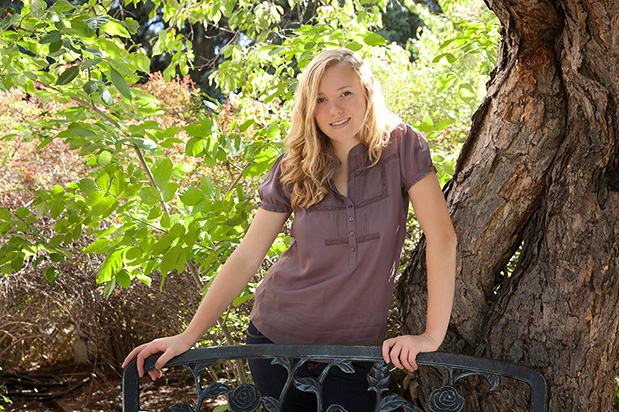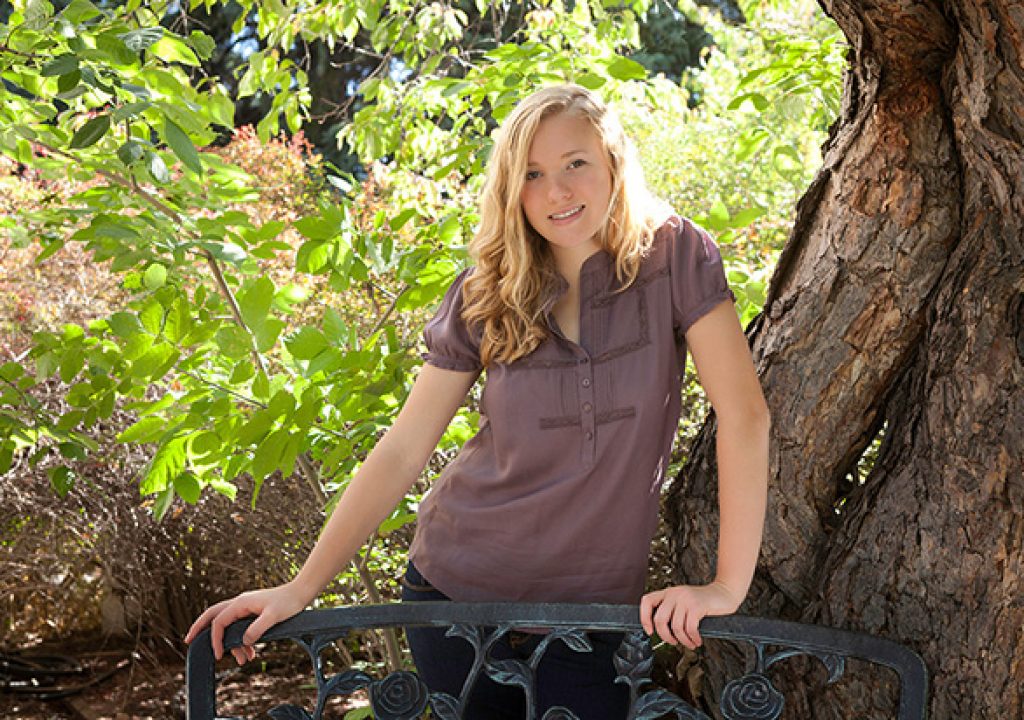
Portrait studios in the last few decades have traditionally made most of their gross and profit from senior portrait days in the short June-September season. Prices were high, and everybody went to studios; it was required. Now it seems anybody can be a portratist – and how the quality has suffered. This is part 1 of a 3-part series.
Senior pictures is still a great specialty to work if you’re building a portrait business or working as a weekend photographer. No one is going to forego a senior picture of some kind; so the market is still there. You just have to figure new ways to get the business away from studios on the one hand and amateurs on the other. Push the envelope.
The lead image pose builds on a traditional feel, but with a casual reality that sings. Soft, somewhat flat lighting on the face under the tree is made dramatic by hot, blown-out highlights on blond hair. Note choice of outfit fits color palate, leads the eye to the face and has a soft attitude. The body is gently turned and leaning – by design the body language matches the curve of the tree trunk.
Posing in the random environment with found objects.
Your competitors are actually three-fold: popular, experienced studios, aspiring photographers like yourself and the surprise is parents or relatives with decent cameras. Like so many other services, mid-range price and quality has all but disappeared.
The fact that so many families now look to a photographer-enthusiast rather than going the admittedly more expensive route of a pro studio works both for and against you as the up and coming photographer. You will find more potential clients, due to cost concerns and public perceptions, but inexperience can easily mark two strikes against you, first with dangerous mid-range price, and second with quality no better than mom’s and dad’s snapshots.
The secret is to act like a long-time seasoned pro.
-
Know your client.
-
Cookie-cutter backgrounds and poses are out.
-
Take more images than you need; take changes with lighting, posing and exposures.
-
Own your technical, camera-side ability with light.
-
Great posing is often the result of making more images.
Pre-production is a must. It’s an unacceptable approach to just show up and expect your natural ability will produce a great portrait. Seniors are a different, suspicious breed. They are waiting, with attitude, to see how good you are. They’re not going to hand you a great smile if they don’t trust you and believe in your professionalism. Know the interests and a bit about the personality of each senior, so you can start a relationship. For women photographers particularly this is really easy as a mom-to-mom of 20-some to mom conversation. Mothers will tell you everything about their kids – just ask. You’ll find out everything you need to know in a few minutes.
Remember old yearbooks where every man wore coat and tie, every woman had pearls and a drape? No, no and no longer! Once you hear about a senior’s life you can suggest personal locations, clothing and have inspiration about how to elicit natural body language. Be inventive with locations. You’ll sell better, and a fun “set” will boost the client experience, and can help you cover small faults of lighting or posing.
Cool quotient rules the day. Read that expensive designer jeans. For this example I chose a mildly grungy background that has complimentary colors and helps to set off the contrast between jeans outfit and the lace top. The bending pose is graceful, shows off the pretty figure, and contributes a dynamic feel. The angle of the hair adds to it. Spotty light is controlled into directionality with a translucent flat, but allowed to hit hands and wall.
Take a few extra moments to get your subject in a good location, adjust the light and then work it! One of two images will be a hit-or-miss situation. Change the turn of the body, turn of the head, smile or not, include hands or not, closeup, ultra closeup or 3/4. If the set is right for the subject, this approach will net you several winners. Experience at directing the session is what you need. Studying magazine ads will suggest styling ideas. Try to keep your senior loose and involved as an active partner in creating great pictures. You’re in control; express your enthusiasm. Once you gain trust, your “model” will do anything you say to make him or her look good.
Generally, you’re looking for a lighting pattern that is directional on the face, but not harsh. The very easiest way to find this light is under trees, an overhang or in the shade of a building. The most difficult light is raw, overhead sun or spotty, sunlight through leaves. Yet, rules are made to be broken. Never hesitate to take a chance with high contrast or very soft flat light. For instance, harsh bands of light coming through louvers can be dramatic, arty and full of senior attitude. Practice “seeing” light is key.
Once you “find” the light, you’ve got to pose. You’ve chosen locations with pre-knowledge of what will move your senior. No one is instantly at home in front of the camera. The hardest thing to do, as the subject, is to stand up, hands at sides and create an expression for the camera. Something, such as a chair back, a branch, even just hands clasping knees puts a physical and psychological barrier between that person and you that is very comforting. This is why leaning on or around trees has been a very popular scenario. The subject does not feel so exposed. You’ll find random things in a prime location that can be used as a seat, something to lean on, something to make a pose come alive. All this will culminate in mood, style and personality. Your senior looks to you for direction, and has high expectations of looking and feeling natural, fashionable, smart and cool.
This is the biggest pro-hint and it bears restating: once you’ve got a scenario going, make lots of images. Turn your subject, turn the face, move your camera, change expressions. Early on, in film days, I was permitted by my studio employer to make just 12 frames. I moved each senior to 12 different backgrounds, and didn’t have any experience in changing expressions or the 3/4 length pose. Not a very good approach then – this would be unthinkable by today’s standards.
Behind the scenes there are a few other things you need to do to to provide a fantastic experience for your client. Yes, your eventual sale will depend to great extent on the experience you provide.
- Scout locations in advance for best time of day lighting and angles.
- Be sensitive to privacy of the session. Most people feel more confident if they are not out in public; but once you invoke a “theatrical” attitude, sometimes an audience can add the excitement of being in the movies or an advertising photo shoot.
- Be early for your session; be set up; make test exposures and white balance in advance.
- Greet clients by name and with an excited attitude.
- Take a serious look at clothing. Nobody wants just one outfit or scenario: 2,3 or even 4 or 5 changes may be wanted. Discard unattractive, improperly laundered garments, while of course playing up popular torn jeans and t-shirts with attitude. Be sure to charge for the number of outfits demanded, or you may do lots of work and in the end the client will pick just one.
- Watch the senior carefully to pick up on natural gestures and expressions to build upon while you pose.
This location is a “word wall” at a local college on a public street. Portrait timing was set for a weekend when there would be few interruptions by passers by. Lighting was full overhead sun, modified with large translucent flats to diffuse light. Note advertising-style turn of the body and the serious, penetrating expression.

